Imagine this...
You’re at a high-end restaurant in Las Vegas, a little boozy from your pre-dinner cocktails, and you just ordered a delicious steak from the menu.
Twenty minutes pass. The server brings it out, and you dig in with a smile on your face...but, to your surprise and disgust, the steak is ice cold.
So what happened?
The cook didn't get the steak to the right temperature before serving it to you.
You might be doing the same with your PPC funnel and the visitors you’re trying to convert.
The temperature of your call-to-action (the steak) has to match the intent temperature of the visitor (the person dining) based on where they’re at in the PPC funnel.
The only problem is that your visitors aren’t sticking around to tell you that the steak is undercooked. They just bounce instead.
This is why so many digital marketing advertisers fail when they try to use the same calls-to-action on the Google Ads Display Network or in Facebook ads as they do on the Google Ads Search Network.
In this article, we’ll teach you all about PPC traffic temperature and how it relates to your PPC funnel and the PPC channels you might be using.
Let’s get started.
- What exactly is the PPC funnel?
- Visitor intent as a temperature scale
- Ice cubes down pants traffic
- Someone peed in the pool traffic
- Straight-up volcano lava traffic
- How does PPC traffic temperature relate to your PPC funnel?
- How do your PPC funnel and traffic temperature relate to different PPC mediums?
- Finally, the golden conversion
- How’s your traffic temperature match looking?
Get brand new PPC strategies straight to your inbox every week. 23,739 people already are!
What exactly is the PPC funnel?
The PPC funnel is a multi-stage process that a customer goes through from the very first moment they discover your brand to the moment they convert and make a purchase—all, of course, specifically within your PPC platforms vs. all traditional marketing channels.
While the PPC funnel is an important standard concept you need to know, you need to learn about traffic temperature before you can understand how to succeed with your funnel.
So let’s do just that by jumping right into traffic temperature.
Visitor intent as a temperature scale
Now that you know some of the steaks you’re serving your PPC visitors are cold, let’s look at the different stages some of your visitors go through before they actually end up paying you any money.
In the simplest terms, you should categorize your PPC traffic into three different temperature categories:
- “ice cubes down pants” traffic
- “someone peed in the pool” traffic
- ”straight-up volcano lava” traffic
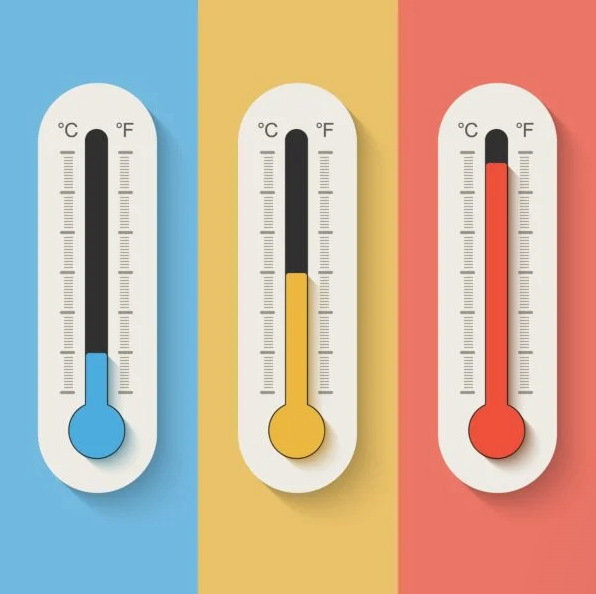
These three main temperatures fall in line with the major parts of your PPC funnel, which we’ll discuss a bit later.
First, let’s look at what we mean by each temperature category.
Ice cubes down pants traffic
First off, have you ever had someone put ice cubes down your pants? It’s jarring, you’re unprepared, and it’s just not what you've ever expected.
I ask because there’s a very strong chance you’re doing it to your visitors right now.
As I mentioned earlier, before you can expect people to convert on your macro conversion (the ultimate goal of your PPC campaigns), you must get them to take micro conversion steps first.
It’s why Uber has decided to lower the threat (and heat) of their mobile ads from their super aggressive call-to-action of “Making extra money with Uber”...
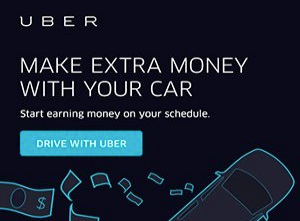
…to something of a lower (and colder) threat, like this:
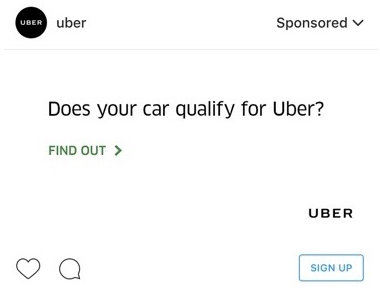
Here’s another example: for one of our clients, we were having no problem turning “someone peed in the pool” PPC paid search traffic (more on this below) to account creations through a landing page with a hero shot like this:
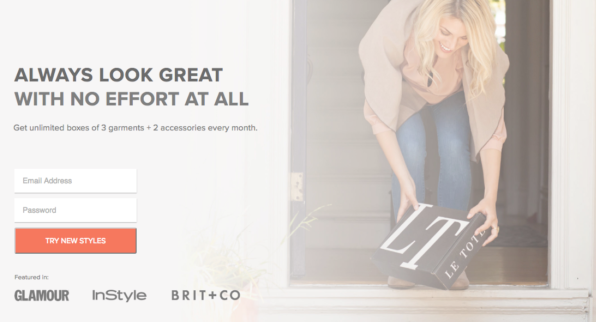
But once we tried to migrate this landing page for Google Ads Display traffic, it sucked.
Why, you might ask?
Most likely because the messaging of the offer/call-to-action didn’t match the colder temperature of the newly-launched Display traffic.
Google Ads paid search traffic has a stronger intent to convert than Google Ads Display traffic when comparing the same call-to-action.
So, we had to cool it down a bit and match the traffic temperature of Google’s Display Network.
Matching traffic temperature and conversion intent
To match the “ice cubes down pants” PPC traffic temperature and conversion intent of display traffic, we lowered the threat of the call-to-action by changing it from a “free account creation” to a simple newsletter subscription, like so:
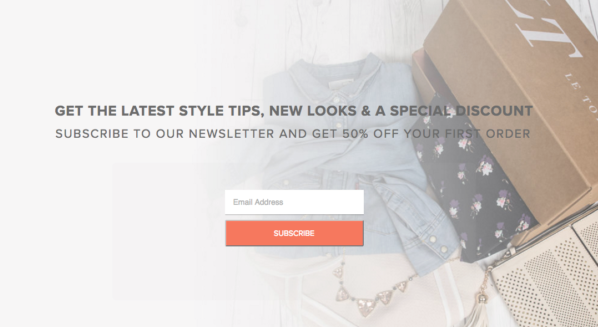
After someone converted on the page above, we then gave them the option to create an account on the confirmation landing page.
Lo and behold, the bulk of those email subscription converters decided to keep going and create an actual account, too (which was our original conversion goal for search traffic).
So what happened here?
Because we noticed that display traffic was in the “ice cubes down pants” temperature range, we lowered the threat of the call-to-action to something that would get peoples’ feet in the conversion door.
Then, because of the psychology behind multi-step landing pages, it was easier for us to upsell the account creation conversion afterward.
This is the same idea that Dr. Robert Cialdini presents in his book Influence: The Psychology of Persuasion:
“Once we’ve made a choice, we will encounter personal and interpersonal pressures to behave consistently with that commitment.”
Dr. Robert Cialdini
Best practices for cold PPC traffic
The goal of your “ice cube down pants” traffic should be to gauge their level of engagement (e.g., their time on site). Sometimes, all you want is to capture the “time” of the cold traffic visitors and then retarget later with an offer that’s higher up on the temperature scale.
So don’t be super aggressive or throw your piping-hot offers at them right away. Let them get to know you comfortably.
And if you’re lucky, you’ll get them to opt into a low-threat offer.
Here are some of the call-to-action ideas to use for ice-cold traffic:
- content marketing (like blog posts, videos, podcasts, etc.)
- white papers, guides, and other downloadable PDFs
- quizzes, surveys (to spur engagement)
Someone peed in the pool traffic
You know that feeling when you’re swimming around in the pool and you find a warm spot?
You kind of like it at first, but you’re not really sure if you should stick around.
You’re thinking, “Hmm. What…is this?”
That’s the same feeling your visitors get when they’re the “someone peed in the pool” type of traffic.
Your call-to-action on your landing page will either make them leave the pool (AKA your landing page), or they’ll be like me and won’t care (I know, somewhat gross, but I’m just being honest), and they’ll stick around to convert.
There are other definitions out there for warm traffic, but I’m going to speak in terms of PPC traffic.
The “someone peed in the pool” type of visitor is searching for what you have to offer or engaging in your content. This visitor is NOT a display traffic visitor who just happens to click on your image ad for the first time (these visitors have no real interest in you).
This visitor is on Google, Facebook, etc., and has some intent to do business with you.
They’re just not sure whether they want to do business with you yet. They might be looking at your competitors or just plain thinking it over.
As they border on the ice-cold/lukewarm seesaw, you can use your ads to sway them to consider your offer instead.
At this pivotal stage, don’t forget that on platforms like Google Ads and Microsoft Ads (previously Bing Ads), you can target competitor keywords like
- Company X alternatives
- companies like Company X
- Company X competitor
Best practices for lukewarm PPC traffic
In a nutshell, lukewarm traffic is either familiar with you or knows what you do. Usually, this type of traffic is more expensive to acquire compared to ice-cold traffic.
The goal of your “someone peed in the pool” traffic is to generate leads through some type of conversion or sales funnel that you’ve created or to get them to buy a lower-ticket item.
Here are some of the call-to-action ideas to use for lukewarm traffic:
- the same opt-in offers as the ice-cold traffic, but with the goal of slightly increasing the “ask” of the offer
- consultations
- longer webinars
- software trials
- low-dollar items
What happens after you get “someone peed in the pool” traffic to convert?
The path to your end goal (the macro conversion) should now be much shorter than the distance your “ice cubes down pants” traffic would have to go.
Straight-up volcano lava traffic
You know those raving fans you have that are already sold before they actually buy? That’s your “straight-up volcano lava” traffic.
This type of traffic loves you.
They’ve either already bought from you or they’ve consumed so much of your content that they’re an expert in your brand.
In the PPC world, your hot traffic is actively searching for your brand name via search engines or in multiple retargeting audiences because they’ve been to your website or landing pages.
Best practices for hot traffic
Suppose you’ve identified your “straight-up volcano lava” traffic. In that case, your biggest goal isn’t necessarily to get them to convert at a higher rate, but to increase the value of their conversion.
What I mean by that is, if you’re in the lead generation space, you can increase your prices to have higher margins.
If you’re in the eCommerce space, then your hot traffic usually has higher average order values, too.
If you’re in the SaaS space with fixed pricing, then look forward to longer retention rates.
The cool thing is that all your ice-cold and lukewarm traffic can eventually move towards the “hot” traffic stage and stay there.
The goal of your “straight-up volcano lava” traffic is to siphon them as quickly as possible to the stage where they pay you money.
Don’t just try to oversell leads that already have their credit cards out.
Here are some call-to-action ideas to use for hot traffic:
- direct client/customer opportunities
- bigger event you’re putting together
- higher-paid ticket items like webinars or consulting
How does PPC traffic temperature relate to your PPC funnel?
At KlientBoost, the terms TOFU, MOFU, and BOFU are commonplace in all our conversations. And if you’re scratching your head about the TOFU part…no, we’re not talking about soybean jelly.
TOFU, MOFU, and BOFU are the three simplest ways to break down your advertising funnel into its major parts: top-of-funnel (TOFU), middle-of-funnel (MOFU), and bottom-of-funnel (BOFU).
And if you’ll notice... there are also three major traffic temperatures that we mentioned earlier, which fall exactly in line with the TOFU, MOFU, BOFU system.
To help illustrate where these three funnel breakdowns are in a traditional funnel you might see, we’ll reference this handy funnel example from Moz.
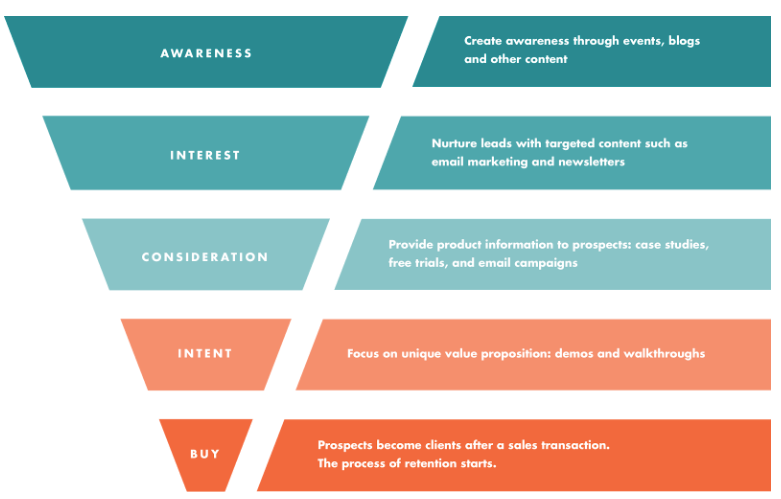
Let’s start putting this together.
Top-of-funnel (TOFU) ice cubes
Your top-of-funnel audience is the coldest audience out there. Like we mentioned earlier, they either don’t know you yet, or they know you very, very vaguely.
Your top-of-funnel audiences are typically in the “awareness” to “interest” phase of a traditional funnel.
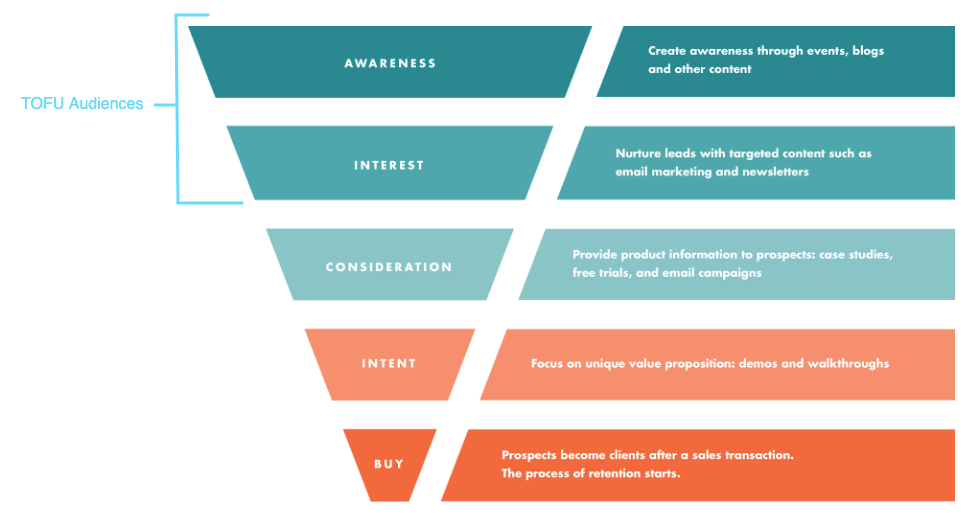
They’re likely to be most receptive to non-threatening offers that don’t require much commitment from them.
Advertising to TOFU audiences helps you
- build more brand awareness
- get more prospects ready to move down the funnel
- build bigger retargeting lists on the backend
- have more BOFU prospects to convert
One trick of the trade: Never underestimate the value of advertising to TOFU audiences.
Middle-of-funnel (MOFU) lukewarm water
Your middle-of-funnel audience is on the border of no intent and high intent. A lot of these types of customers might not yet be in the mind frame to buy, but could be pushed in that direction more easily than a cold prospect.
They’re typically in the “consideration” phase of a traditional funnel, but could be somewhat in the “interest” phase as well.
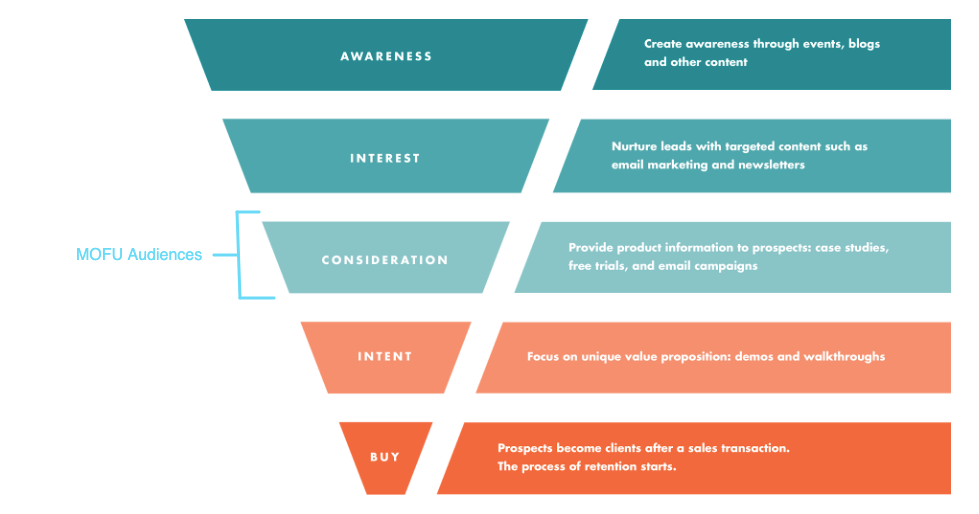
MOFU prospects’ decisions are more likely to be influenced by social proof (like reviews or good press backing up your product or service). They might want to look into a free version of a product, or might be interested in a lower-commitment purchase.
Advertising to MOFU audiences helps you
- convince your potential customers you’re better than your competition
- convince your potential customers your product or service is legitimate
- build more interest and desire to buy by highlighting why someone needs your product
- get your potential customers familiar with your product through freemiums or free trials
One trick of the trade: If you’re offering a freemium or free trial version of your product, you’re likely to get more MOFU people to try it if you don’t require any credit card info to access it.
Bottom-of-funnel (BOFU) hot lava
The bottom of the funnel is where the buyer actually converts from a prospect into a customer. At this stage, your PPC traffic is hot—these users are well aware of your offer and might even be searching for it specifically.
In simple terms, prospects at the bottom of the funnel are ready to take action. So if you can convert more of them, you’ll see the most direct impact on your campaigns’ performance, especially if you’re focused on the right PPC metrics.
In a traditional funnel, they’re in the “intent” phase.
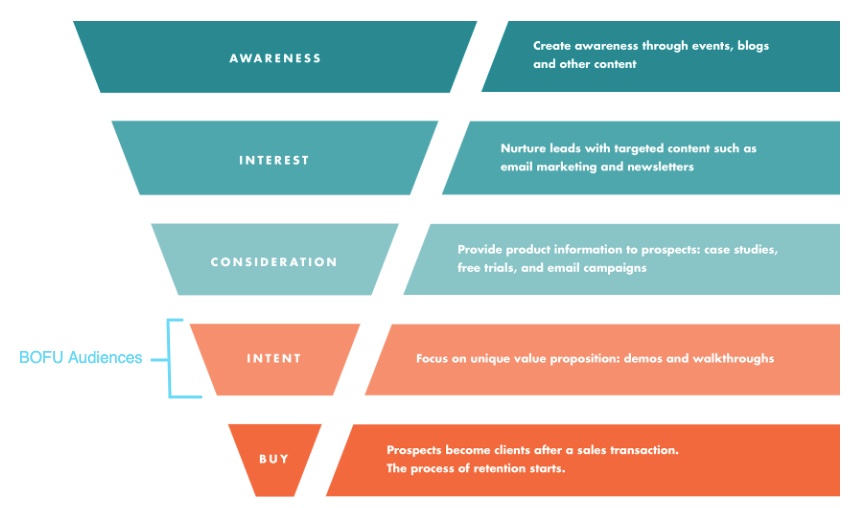
Advertising to BOFU audiences helps you
- improve conversion/sale volume
- boost your ROAS
- build your customer loyalty base (from the increase in sold prospects)
- build your customer-to-customer referrals (from the increase in sold prospects)
One trick of the trade: You can’t advertise only to BOFU audiences, and most of the time, very new brands can’t advertise to them at all until they build up their TOFU and MOFU audiences.
Why?
It’s a funnel.
The majority of customers enter through the open top of it. Very, very few drill a hole in the side of the funnel and start in the “intent” phase. So take the time to push people through your funnel for a healthy BOFU strategy.
Focus on ROAS when evaluating BOFU advertising efforts
Whereas metrics like conversion volume don’t tell you much about how profitable you actually are, focusing on return on ad spend (ROAS) puts the spotlight on the tangible results generated by your campaign.
In PPC tracking terms, ROAS divides the revenue from an ad campaign by the cost of that campaign. Unlike return on investment (ROI), which calculates the return for your campaigns overall, ROAS focuses on the specific ratio of ad spend to revenue.
In other words, ROAS provides a focused look at your digital ad campaigns. ROI includes other components like salary and operating costs.
With most paid search campaigns, a 3–4x ROAS will push your campaign into profitability.
Obviously, the ultimate goal is to keep growing well beyond 3x ROAS, but this should give you an idea of where you stand. Improving the efficiency of your conversion funnel, however, can increase your ROAS without a corresponding increase in your ad budget.
If you’re a lead generation business, and your sales happen offline after the lead is received, you’ll need to set up offline conversion tracking to evaluate your ROAS relative to your leads.
How do your PPC funnel and traffic temperature relate to different PPC mediums?
Now that you’ve had a look at a traditional funnel, take a gander at this one:
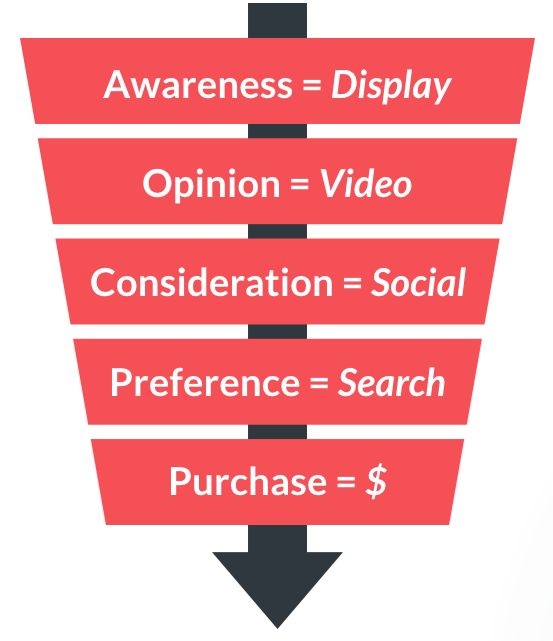
This funnel is a bit different—it gets to the meat of how your funnel stages look relative to your available PPC mediums. That’s what you really need to know.
To recap, the stages of the funnel relative to their temperature are
- awareness = cold as cold gets (TOFU)
- opinion (sometimes known as “interest”) = lukewarm (TOFU/MOFU)
- consideration = warm (MOFU)
- preference (sometimes known as “intent”) = hot/lava (BOFU)
- purchase (sometimes known as “decision” or “sale”) = end goal, in which the volcano’s literally erupting
Understanding what part of your funnel you’re advertising to, what the temperature is, and how to best appeal to those audiences with your offers is what PPC success is all about.
To tie this all together once and for all, let’s now look at some of the various PPC channels relative to the funnel stages and their temperatures.
Ice cold: Display
If you’ve ever launched direct Display Network campaigns (not retargeting), then you probably know it’s challenging to get them to convert at the bottom of the funnel.
Most of the time, PPC visitors that come from a regular display click enter your funnel at the very top, in the brand awareness stage. And while display advertising can still work as a direct response PPC channel, the time it takes for the visitor to travel down to the purchase stage can be quite long.
When it comes to your potential customers’ journeys and attribution, it’s important that you don’t discredit display advertising, even when it doesn’t lead to a direct conversion.
This is because there’s still a really good chance that display is leading to a ton of assisted conversions.
If you go into your Google Analytics account and view the Conversions > Multi-Channel Funnels > Assisted Conversions, with a look-back window of 30–90 days, you might see something like this:
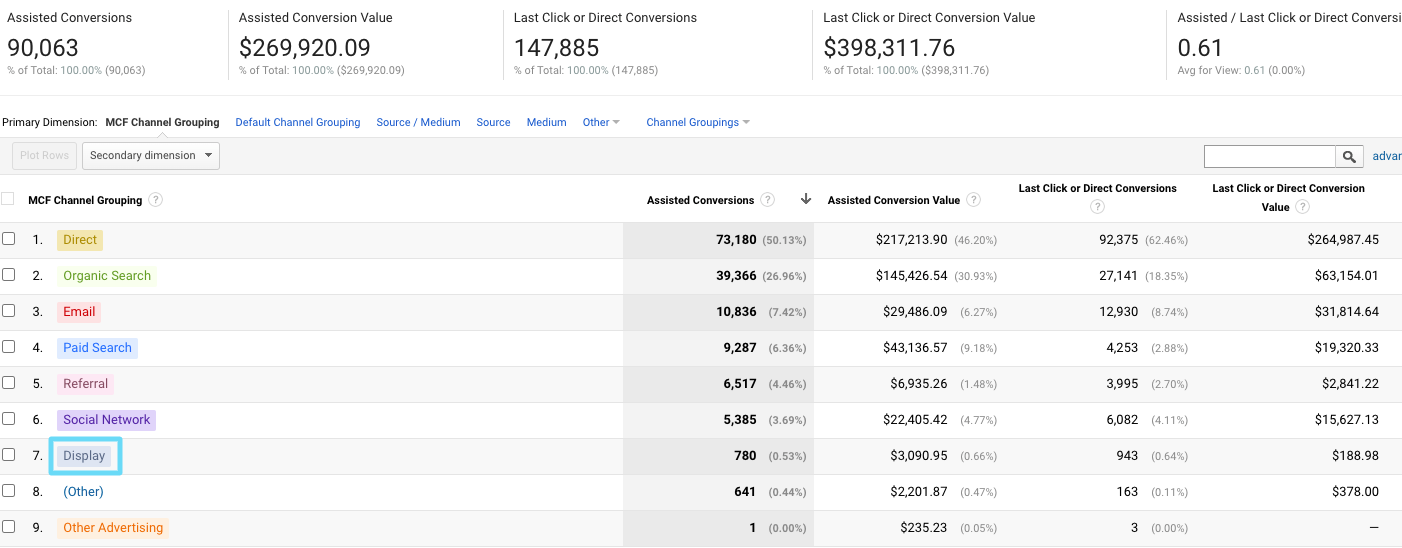
Display’s doing its part here, assisting at the very top of the funnel
Depending on the data from the attribution model you use (most companies use last click), you might be tempted to pause your display campaigns because they aren’t the last conversion touchpoint in your PPC customer journey.
But as the example above shows, your other PPC channels may suffer as well from the loss of assisted conversions that display initiated.
Lukewarm: engaged video viewers
A step closer to the actual sale, you’ll find that video as a PPC medium, both on Google and Facebook, has a higher level of engagement compared to regular display advertising.
For example, many times, we’ve found that YouTube visitors can lead to a sale up to four times faster than a display conversion.
And with Facebook Ads, a couple of studies found that video led to 2–3x better CTR and 20–30% higher conversion rates than standard image ads.
Video engagement can also be tracked as “percentages of video watched.” The longer the watch time, the higher the likelihood that they didn’t accidentally click on your video ad like they would a regular display ad. So you’ve got more certainty that these audience members are actually engaged.
In addition to that, you’re able to create new retargeting audiences through Google Ads and Facebook, depending on how long a visitor has watched your video.
The longer the attention span, the higher the chance of a conversion.
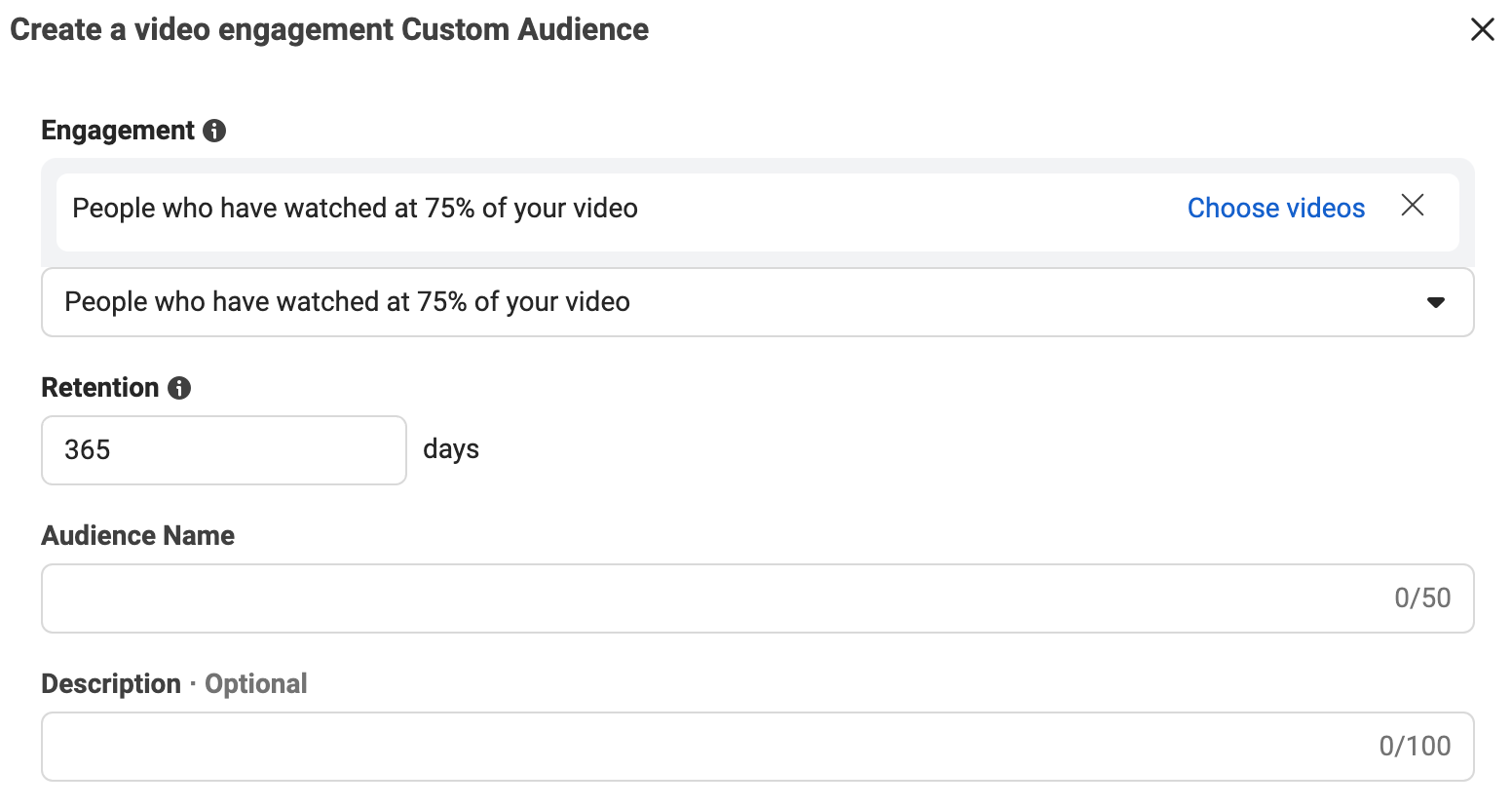
This is the type of audience you can start serving a “someone peed in the pool” type of offer to.
Warmer: super-specific social
Further down the PPC conversion funnel, we find that direct social advertising allows you to target your prospects with more accuracy compared to display advertising.
A few social media advertising networks are
On social media networks, more detailed targeting options allow you to layer in more accurate demographics, behaviors, and interests for an audience that’s still large but more focused.
In addition to that, you can use Facebook Lookalike Audiences to find people that are like those who are already converting on your site or landing page.
We’ve written quite a few articles on ad tips for Facebook and different types of Facebook ad targeting that you can use to make better optimizations. Those optimizations coupled with “someone peed in the pool” or even hotter offers will likely boost your funnel’s performance.
Visitors who enter your funnel via social media could be just two or three steps away from turning into actual sales or—better yet—turn into sales right away.
Hot: search ads
When it comes to PPC advertising, it doesn’t get any better than having your target audience tell you what they’re interested in.
That’s what search advertising is in a nutshell: a reactive, demand-harvesting channel.
There are, however, two major downsides:
- Ad space is limited on Google and Microsoft Ads, which means that supply is short and CPC costs are rising.
- All keywords you bid on are not created equally. In fact, there are smaller micro funnels within search campaigns where keywords don’t just have different conversion rates, but different actual sales rates.
If this was your current performance, which keyword is performing best?
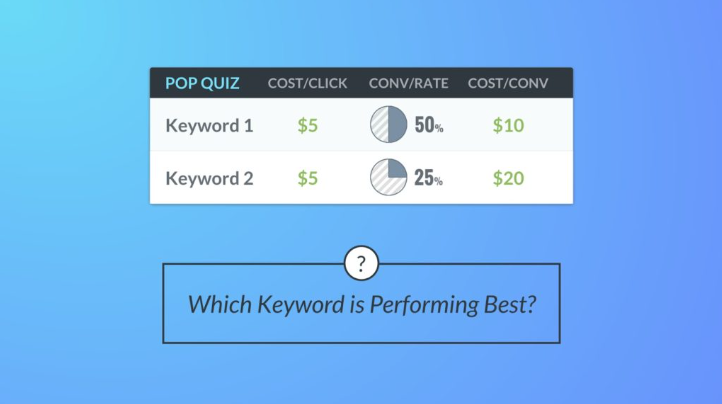
But what if you’re in the lead gen/SaaS space and wanted to track the sales rates (not just conversion rates)? Now which keyword is performing better?
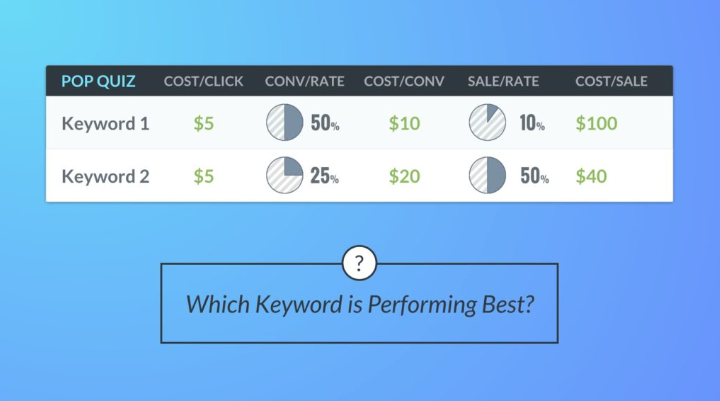
Because of this, your CPA goal for your search campaigns shouldn’t be a single blanket CPA.
Not only do your keywords have different sales rates, but the PPC customer journey starts differently for people depending on which keyword they search around.
For example, a search like “buy shoes” isn’t as hot as a search like “buy men’s Nikes.”
You can typically use a hotter offer for both, but the same offer might not work for both.
You might need to show the “buy shoes” crowd an offer for free shipping or 15% off your first order. And you might be more successful showing the “buy men’s Nikes” searchers an offer like “30% off select Nike shoes.”
Search is a hot medium generally. But think about how hot when looking at your keyword groups.
Lava: high-intent retargeting
It doesn’t get much hotter than high-intent retargeting audiences.
Note: Retargeting audiences (AKA remarketing lists) of all website visitors might not be super hot. Some of those visitors may have only been to your site once for five seconds before bouncing, but they’ve still been added to your all visitors retargeting audience.
On the other hand, a retargeting audience of people who watched 95% of your video…now that’s a more engaged, high-intent retargeting audience.
When making high-intent retargeting audiences, you’re looking for interest indicators that only hot prospects exhibit.
A few more examples of this are
- visiting a pricing page
- time on site exceeding three minutes
- visiting more than two pages on your site
- frequent blog readers
- newsletter subscribers
These visitors are fireproof. Typically, serving hot/lava offers to them can result in exceptional benefits to conversion metrics and sales because they’re already an inch away from the purchase.
That’s the end of the marketing funnel—next is the finish line, AKA the final conversion.
Finally, the golden conversion
Okay, so after all this, you got the visitor to convert. But have you made the sale?
If you’re in eCommerce, your answer is probably yes, they checked out, the job is done. Unless, that is, you have a sweet thank you page that helps with upsells.
But if you’re in the lead gen or SaaS space, your work toward your KPIs (key performance indicators) has just begun.
Depending on the volume of conversions you’re getting (remember, not sales), you’re able to start tracking future sales that come from those conversions down to the keyword, placement, or audience level.
With enough sales volume, this will help you start identifying what’s actually making you money and what isn’t when it comes to your different PPC marketing campaigns.
One of the quickest ways within Google Ads is to use ValueTrack parameters and append that data to your final URLs. Then, by using hidden fields on your lead capture form, you can track more data behind the scenes to understand what’s turning into sales.
You can even import that sales data back into some platforms like Google Ads to see those results in-platform, through offline conversion tracking.
This also helps you identify which types of PPC channels (search, social, video, display) have longer sales cycles and what you can do to shorten that time gap, if possible.
How’s your traffic temperature match looking?
The reason we have different PPC temperatures is the reason why some people are obsessed with funnel marketing.
It helps you understand why improving your PPC marketing funnel could be better time spent than a lot of other strategic tests.
Most importantly, when it comes to PPC traffic temperatures, take a good look at the marketing strategy behind the calls-to-action/offers you’re currently using to attract conversions.
Is your lukewarm call-to-action being used on ice-cold traffic? If so, make sure you test “lowering the threat” of your calls-to-action to see how it improves performance.
And always keep in mind: don’t treat all your PPC visitors the same.
ROAS is better when you have multiple PPC strategies to attract and convert.
You’ve got all the know-how you need to make the perfect funnel, so why not amp up your PPC knowledge even more?
Our next article on the PPC metrics will set you up for even more success by covering the KPIs and data you need to prioritize.